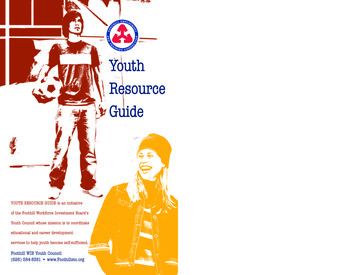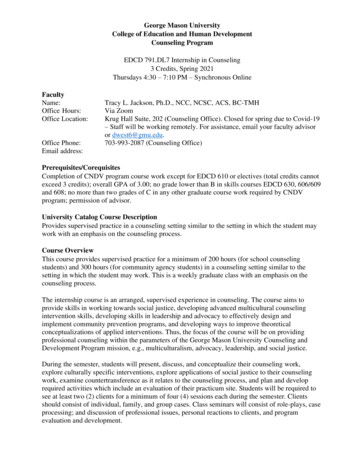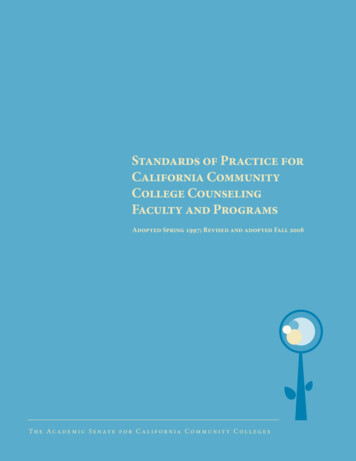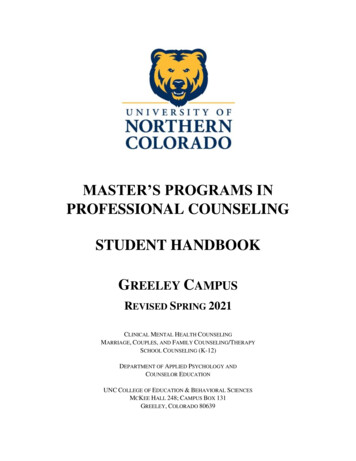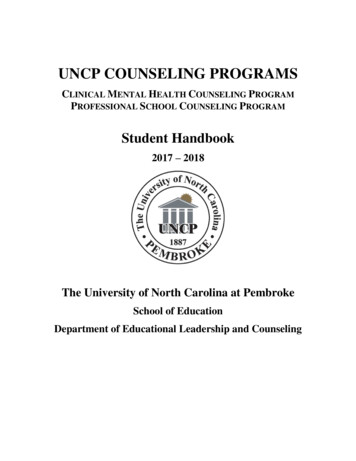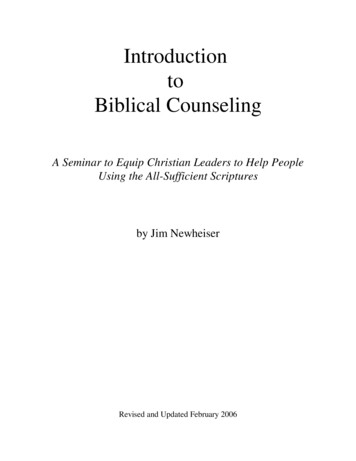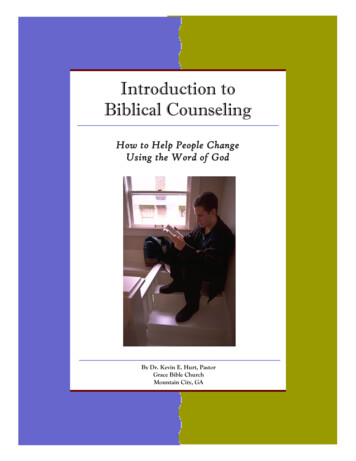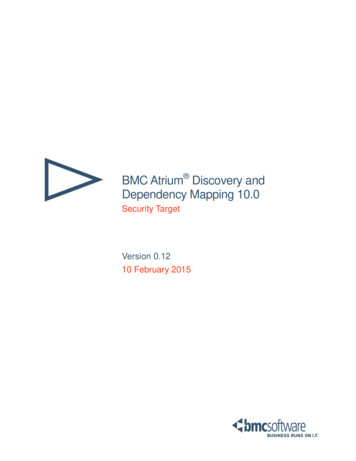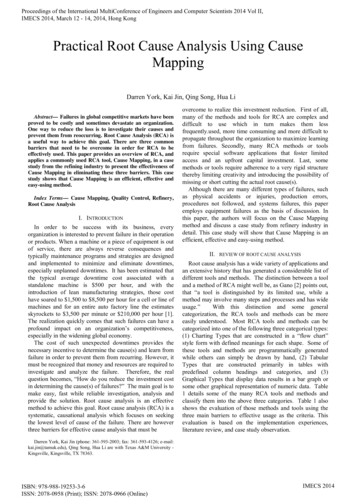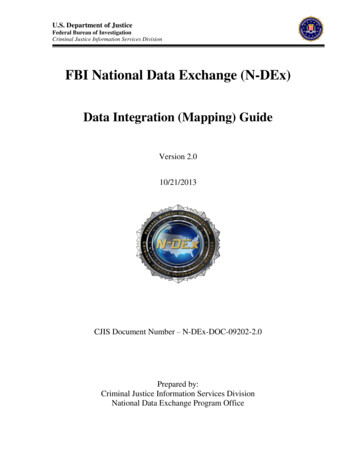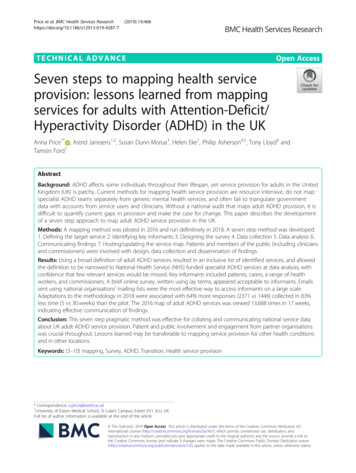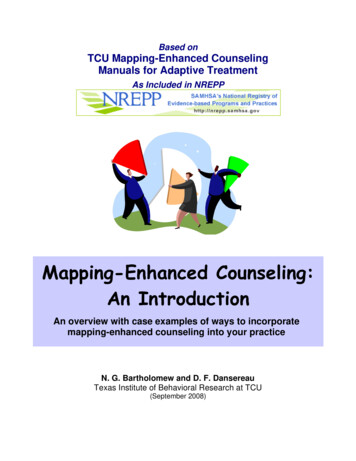
Transcription
Based onTCU Mapping-Enhanced CounselingManuals for Adaptive TreatmentAs Included in NREPPMapping-Enhanced Counseling:An IntroductionAn overview with case examples of ways to incorporatemapping-enhanced counseling into your practiceN. G. Bartholomew and D. F. DansereauTexas Institute of Behavioral Research at TCU(September 2008)
TCU Mapping-Enhanced CounselingTCU Mapping-Enhanced Counseling manuals provide evidence-basedguides for adaptive treatment services (included in National Registryof Evidence-based Programs and Practices, NREPP, 2008). They arederived from cognitive-behavioral models designed particularly forcounselors and group facilitators working in substance abuse treatmentprograms. Although best suited for group work, the concepts andexercises can be directly adapted to individual settings.When accompanied by user-friendly information about clientassessments that measure risks, needs, and progress over time, TCUMapping-Enhanced Counseling manuals represent focused, time-limitedstrategies for engaging clients in discussions and activities onimportant recovery topics. These materials and related scientificreports are available as Adobe PDF files for free download athttp://www.ibr.tcu.edu. Copyright 2008 Texas Institute of Behavioral Research at TCU, FortWorth, Texas 76129. All rights reserved. Permission is hereby granted toreproduce and distribute copies of these materials (except reprintedpassages from copyrighted sources) for nonprofit educational and nonprofitlibrary purposes, provided that copies are distributed at or below costs andthat credit for author, source, and copyright are included on each copy. Nomaterial may be copied, downloaded, stored in a retrieval system, orredistributed for any commercial purpose without the expressed writtenpermission of Texas Christian University.Texas Institute of Behavioral Research2TCU ( 2008)
TCU Mapping-Enhanced CounselingTable of ContentsIntroduction: TCU Mapping-Enhanced Counseling . 4Description: Introduction and overview to working with TCU MappingEnhanced CounselingPart 1: Overview of Mapping-Enhanced Counseling Strategies . 8Description: Background and primer for using node-link mapping forindividual and group workPart 2: The Mapper’s Dozen . 15Description: Twelve multi-purpose guide map templates with examples ofcustomization to tailor maps to treatment needsPart 3: Case Studies with Maps . 39Description: Ideas for using maps to work with clients around issuesidentified as part of treatment planningAppendix: Bibliography . 72Description: Bibliography of mapping research studiesTexas Institute of Behavioral Research3TCU ( 2008)
TCU Mapping-Enhanced CounselingIntroduction:TCU Mapping-EnhancedCounselingTexas Institute of Behavioral Research4TCU ( 2008)
TCU Mapping-Enhanced CounselingWhat is TCU Mapping-Enhanced Counseling?This manual will introduce you to TCU Mapping-Enhanced Counseling (TMEC) andshow you some ideas about how to use it. The TCU/IBR Website (www.ibr.tcu.edu)contains the references, abstracts and other free downloadable manuals that will help youincorporate TMEC into your program. This Website also contains information aboutassessments and other complimentary interventions that can be used with TMEC, as wellas models that show how this integration can be accomplished to facilitate client andorganizational change.TMEC makes use of graphic representations, primarily node-links mapping, to enhanceclient and counselor communication and thinking. The maps that are the basis of TMECuse boxes (nodes) and lines (links) to visually illustrate clients’ thoughts, feelings, andactions and how they relate to each other. There are three basic types of maps:Free maps that are drawn “from scratch” as counseling proceeds or as homework.Guide maps are “fill in the blanks” templates selected from a collection that coversa variety of common counseling topics. Guide maps are completed by filling innodes for discussion during the session or as homework.Information maps are prepared independent of the clients by outside experts orcounselors to present key topics. Information maps are used primarily duringpsychoeducational sessions.TMEC is designed to give the counselors the flexibility to tailor the use of the node-linkgraphic representations to supplement and compliment their preferred method ofcounseling, as well as to meet the needs and preferences of their clients. Consequently,in doing TMEC a counselor may use maps individually or in combination to stimulatediscussion, clarify and organize thinking, and to increase memory for what has beencovered.It is important to understand that TMEC can be used as a framework for most group andindividual counseling methodologies, including cognitive behavioral, psychodynamic,motivational enhancement, or 12-step-oriented. In essence, TMEC provides anapproach-independent visual adjunct to spoken language.What are the origins of TMEC?TMEC evolved from earlier work on graphic representation to improve thecommunication and thinking of teachers and students. The success of visual approaches,in particular node-link mapping, in education led to applications in counseling starting in1989. Since then, mapping has undergone extensive research and development in avariety of counseling arenas.Texas Institute of Behavioral Research5TCU ( 2008)
TCU Mapping-Enhanced CounselingWhat is the evidence for the effectiveness of TMEC?There are over 20 studies that show that clients randomly assigned to TMEC have betterduring and after treatment outcomes than clients who are randomly assigned to“counseling as usual.” In addition to this empirical evidence, there is also substantialpragmatic evidence represented by the adoption of TMEC by numerous counselors andcounseling agencies in the U.S. and other countries (e.g., England and Italy). There arealso key published articles that provide background and guidance on the use of mapping(see Appendix).How do I learn to implement TMEC?There are three ways to learn TMEC: (a) receive formal workshop training, (b) be taughtby colleagues, or (c) self–study the materials that appear on the IBR Website(www.ibr.tcu.edu). There are strong indications that all three approaches can besuccessful. Regardless of the approach, the following points should be emphasized:1) There are many ways to create and use node-link maps. A “good” map is onethat facilitates discussion and thinking. It is important to remember that mapping is anadjunct to good counseling, not a goal in itself.2) Counselors will need time to explore (in some cases by trial and error) how tomerge mapping with their preferred approaches and their clients’ needs. After learningthe “nuts and bolts” of TMEC, it will take a counselor some time to evolve a version ofthis counseling technique that feels comfortable and effective.3) Peer and supervisor support and collaboration make the adoption of TMECmuch easier. A culture of TMEC creates opportunities for brainstorming andconstructive feedback. Counseling session maps also can be used to facilitate discussionsabout clients’ issues and progress as part of supervision.What manuals are available for learning TMEC?There are several manuals available through the IBR Website that can be used to learnthe core elements of TMEC (www.ibr.tcu.edu and click on “Manuals”):The present manual, Introduction to TCU Mapping-enhanced Counseling, is a goodplace to start. You’ll find an overview of node-linking mapping, guide maps, andexamples of using TMEC in both individual and group sessions. Others include:Mapping New Roads to Recovery: Cognitive Enhancements to Counseling – Thismapping “primer” features step-by-step information and practice exercises. It detailsthe use of free mapping (i.e., maps made by counselors and clients from scratch) andcontains examples of counseling session maps.Texas Institute of Behavioral Research6TCU ( 2008)
TCU Mapping-Enhanced CounselingTCU Guide Maps: A Resource for Counselors – This manual presents a collectionof fill-in-the-blank maps that cover numerous counseling topics.Mapping Your Steps: Twelve Step Guide Maps – This is a more targeted manualthat provides guide maps for learning and processing the information in 12 stepprograms.In addition, the IBR Website also features several topic-specific manuals for groupcounseling that use mapping as a primary strategy. Among them:Straight Ahead: Transition Skills for Recovery – This manual uses guide maps andinformation maps for relapse prevention and building social support for recovery.Getting Motivated to Change – This manual uses mapping worksheets to help clientsvisualize decisional balances, self-identify motivations for change, and plan goals.Mapping Your Treatment Plan – This manual presents a mapping-focused guide forworking with clients to establish meaningful and useful treatment goals.Unlock Your Thinking, Open Your Mind – This manual uses mapping to focus onidentifying and changing unproductive cognitive distortions that interfere withtreatment and recovery.How does TMEC fit with client assessments?TMEC has been shown to be especially useful in providing clients with feedback basedon assessment instruments that are used to inform treatment planning or during-treatmentmonitoring. The TCU Client Evaluation of Self and Treatment (CEST) is one of severalavailable instruments that help chart client characteristics at Intake and throughouttreatment. The TCU manual, Using Client Assessments to Plan and MonitorTreatment, provides a concise overview of the utility of the CEST assessments foraddressing client treatment needs and progress. This manual is available for download atthe IBR Website (www.ibr.tcu.edu).In Part 3 of this manual, case studies are used to illustrate how assessment results can beincorporated into a mapping session to help client engage in identifying issues andconcerns they wish to address as part of treatment. TMEC offers a focused strategy forpulling clients into the planning and monitoring process, while at the same time engagingthem in important issues and discussions important for recovery.Texas Institute of Behavioral Research7TCU ( 2008)
TCU Mapping-Enhanced CounselingPART 1:Overview ofMapping-EnhancedCounseling StrategiesTexas Institute of Behavioral Research8TCU ( 2008)
TCU Mapping-Enhanced CounselingWhat is “node-link mapping”?Mapping is a cognitive-enhancement that helps organize information and ideasspatially. Most counselors have been exposed to the helpfulness of graphicallydisplaying ideas and connections. For example, genograms use boxes and lines tohelp clients better understand their family history over several generations.The type of mapping we use in this manual is more commonly known as “node-linkmapping.” (See Appendix for the node-link mapping bibliography.) It was firststudied as a handy tool for helping students take better notes during lengthy collegelectures. In these studies, some students were taught to take notes using boxes torecord central ideas in shorthand (“nodes”). These nodes were connected to othernodes with lines (“links”) representing different types of relationships. The finalproduct often resembled a map or flow chart of the lecture. Other students tooknotes as they would usually take them. The results showed that students who usedthis “node-link mapping” system had better recall, did better on tests, and felt moreconfident about understanding the lecture than did students who took the usualscripted type of notes (see Figure 1.). There seems to be something aboutgraphically displaying information that helps us better understand meanings and beable to recall the information (hopefully when we need to use it.).Figure 1. Simple map of early mapping researchLong-winded lectureStudents wholearned to mapStudents whotook regularnotesBetter scoresBetter recallLower scoresMore confidentabout understandingTexas Institute of Behavioral Research9Less recallLess confident aboutunderstandingTCU ( 2008)
TCU Mapping-Enhanced CounselingMapping as a Counseling ToolMapping was adapted for use as a counseling tool beginning in 1989 as part of along-range project to enhance addiction treatment and study therapeutic process. Akey element – that mapping appears to help foster understanding and support betterrecall – was seen as potentially beneficial to the counseling relationship both forindividual and group applications.Mapping serves two major functions in the counseling process. First, it provides acommunication tool for clarifying information and sharing meaning betweencounselor and client. It can be used effectively with whatever therapeutic orientationor style a counselor follows. Second, regular use of mapping-based strategies helpswith the continuity of care. Mapping worksheets or notes can be placed in theclient’s file, so that discussions of treatment issues (around goals, for example) canbe picked up where they were left off at the end of the previous session. Clients alsomay be offered copies of maps to help focus and task completion between visits.Using mapping as a clinical tool assists the counselor in structuring sessions to betteraddress key issues that are important to the client. Of course, from the client’sperspective, it is the conversation itself that is most important. Mapping can helpmake treatment conversations more memorable, help clients focus, and give clientsconfidence in their ability to think through problems and develop solutions.Another benefit of creating maps with clients is having those maps available forclinical supervision meetings. When mapping is part of the counseling process withclients, this material can be discussed jointly in supervision. Maps placed in theclient’s file document and efficiently outline the work being done in session. Thisprovides a foundation and focus for supervisors to offer specific feedback andclinical guidance.Finally, TCU Mapping- Enhanced Counseling is listed in SAHMSA’s NationalRegistry of Evidence-based Practices and Programs (NREPP). In treatment settingsinterested in fidelity and adherence to protocol when following evidence-basedpractices, the nature of the mapping intervention itself (i.e. producing visualrepresentations) provides for easy documentation. The maps themselves documentthe frequency, focus, and application of their use. In addition, the number of mapsproduced, the types of maps used, the topics addressed, and the client’s involvementin the mapping process provide accurate evidence of counselor-level and client-leveladherence to mapping-enhanced counseling practices.Texas Institute of Behavioral Research10TCU ( 2008)
TCU Mapping-Enhanced CounselingMapping and CollaborationCollaborative counseling approaches are emerging as effective strategies forimproving motivation and goal-setting, and for helping clients feel that they wereheard and respected during sessions. These are seen as building blocks for a strongtherapeutic alliance and for instilling hopefulness and determination as clients begintheir treatment journey. A central skill in collaborative approaches is the elicitingand highlighting of the client’s perspective. This includes encouraging clients todiscuss, with enriched detail, what needs to change in their lives, how they view thechange process, and what steps make sense for what they want to accomplish.When a counselor uses mapping to engage the client, this type of collaboration isnaturally facilitated. Maps are co-created, and the content of a map – the thoughts,ideas, and issues – are those raised and identified by the client. The map provides afocal point for this work as the counselor skillfully elicits from the client whatshould be written down, what should be noted in passing, and what should beaddressed next.As part of a collaborative model of treatment planning, counselors help clientsdevelop a clear picture of what they want to be different or improved as a result ofparticipating in treatment. This logically involves a discussion of goals and thepositive consequences of those goals. It also involves assisting the client inidentifying his or her available resources for tackling those goals. Resources areidentified broadly to include a client’s strengths, relationships, attitudes, thoughts,skills, behaviors, and perceptions.Within this framework, the counselor accepts that a client’s goals may change duringthe process of treatment and that the client is the determiner of when enoughprogress has been made toward a particular goal and when goals should be amended.Likewise, the counselor accepts that a client’s most salient and meaningful goalsmay not reference alcohol or drug use, per se. For example, saving a marriage orrelationship, getting and keeping a job, regaining a driver’s license, or committing toan educational pursuit are more commonly identified goals. Ending or controllingsubstance use becomes one of the factors or ways to achieve these major goals.Texas Institute of Behavioral Research11TCU ( 2008)
TCU Mapping-Enhanced CounselingTypes of MapsMapping CategoriesAs noted, node-link maps are tools that can visually portray ideas, feelings, facts, andexperiences. There are three broad categories of these maps: Free or process mapsInformation mapsGuide mapsFree or process maps: Using an erasable board, flip chart, or paper andpencil, client(s) and counselor can work together to create a map of the problem orissue under discussion. The counselor should take the lead in briefly explainingmapping to the client(s) and providing a starting point for creating the map. Whenpossible, both counselor and client(s) should have pencils or markers so that cocreation of the map is facilitated. Here is an example of a free map or process mapcreated during a group session on “relapse.” In this case, the counselor created themap on an eraser board with group members’ input and then led a process discussionon the issues that were raised:Free MappingPThings Learned fromRelapseP“Finally acceptedthat I need help”Hit rockbottomPPIt had been6 month sinceI usedDenialLOverConfidenceTexas Institute of Behavioral ResearchI can regain controlRealizing it“sneaks” upEx12PIDesire toquit forgoodLegendP PartL Leads ToEX ExampleTCU ( 2008)
TCU Mapping-Enhanced CounselingInformation maps: Information maps have been used in a variety of settingsto help communicate basic information in a readily understandable way.Information maps are usually prepared ahead of time to serve as handouts orpresentation slides. These maps organize facts in a specific content area andpresent them in an easy-to-remember format. Early mapping studies with clientsattending psychoeducational groups on HIV-risk reduction found that informationmaps were useful in helping clients learn and retain information about HIVtransmission and high-risk practices.HIRVRRImmunoDeficiencyHumanCVirusCPeople OnlyCan not bespread by animals,plants, or insectsCSmallest livingmicrobe (germ)Survives by invadingcells and destroyingthemA major problemwith the ImmuneSystem that fightsdiseaseHIV is a human virus that invades and destroys the cells of the immunesystem.AIRDRAcquiredCCan be acquired.In other words,it can be spreadSRImmuneRDeficiencyCCRefers to theimmune system.White blood cellsthat fight diseaseNot working.Deficient.Unable to fightgermsSyndromeCA group of illnessesor symptoms relatedto a specific cause(HIV)AIDS is the late stage of HIV infection, resulting in illnesses and cancers the body can nolonger fight off.Guide maps: Guide maps are pre-structured templates with a “fill-in-thespace” format that help guide the counselor-client interaction during a session,while also allowing ample freedom for self-expression. As part of an individualcounseling session, these maps provide a structure for thinking about and talkingabout goals, personal resources, and specific steps and tasks for arriving at goals.In group work, guide maps can be used as homework or as individual worksheetsthat are then processed and discussed within the larger group. These mappingactivities can provide some assurance that each group member has had a chance tovisit a particular issue personally. Similarly in group settings, guide maps can beused to focus and keep a discussion on track.Texas Institute of Behavioral Research13TCU ( 2008)
TCU Mapping-Enhanced CounselingMapping Guide 1: Exploring Self (Map 1)Chris: A fictional case study (1):StrengthsHealthI’m pretty goodLooking; tall;mostly healthySocial RelationshipsI have a couple offriends and I getalong prettywell with mydaughter.Emotions/TemperamentI really want tochange my life! Ido know what it’slike to be happy.Problem SolvingWhen I’m clearheaded I makepretty good decisions.I can also talk well.Beliefs and ValuesWhat are yourstrengths?I try hard to do the“right thing.” Ilove my daughter.Job/Career?I have computer skillsI have had three jobsin the last 12 yearsI take work seriouslyHow can you use your strengths to improve your life?Once I get control of my drug habit, maybe I can use my skills andlooks to go into computer sales.How useful was this map and discussion?Not useful 1---2---3---4---5---6---7---8---9---10 Very usefulComments:The Mapper’s DozenMapping-enhanced counseling strategies are useful for establishing rapport andtherapeutic alliance, identifying client goals for treatment, and fostering motivationfor working on those goals as part of treatment. The Mapper’s Dozen is a collectionof 12 multi-purpose guide maps that can be customized for different needs and issuesin individual or group settings. These maps, along with examples of differentcustomizations, are included in the following chapter.To get ready for using guide maps with clients, familiarize yourself with TheMapper’s Dozen and how you might use them. Prepare the client for this newapproach to working together. Give the client an explanation about what maps are:“Maps are tools to help us structure our sessions and discussions. They can help us“see” some of the things we may talk about.” Frequently validate and affirm clients’responses in during mapping sessions.Texas Institute of Behavioral Research14TCU ( 2008)
TCU Mapping-Enhanced CounselingPART 2:The Mapper’s DozenTexas Institute of Behavioral Research15TCU ( 2008)
TCU Mapping-Enhanced CounselingThe MapsThe following collection of node-link guide maps can be used to generate ideas anddiscussion around a multitude of counseling issues. The maps can be a step in treatmentplanning, a way to highlight a particular concern, a handout activity for groups, or a“homework” assignment to keep clients focused between sessions.There really is no secret or prescribed way to use these maps. There is no “right” or“wrong” way to add them to counseling or group routines. In fact, although we haveworked extensively with maps over the years, we continue to discover new andinnovative ways to use them with our clients. Or we hear from other counselors andclients about the successful ways they have used a particular guide map to address issues.This “no right or wrong” approach stems from what we believe is the magic of usingnode-link maps in the first place – that being the cognitive enhancement of visually andspatially displaying information, tasks, personal narratives, problems, or envisionedsolutions. The overall “gestalt” of a completed map, in combination with a chance toprocess it in group or individual counseling, is a key factor in its effectiveness.So what is the best way to begin incorporating these guide maps into clinical work? Werecommend rehearsal and practice to become familiar with the maps themselves. First,make yourself copies of the maps and take some time to review them. Next, choose apersonal problem, event, decision, or circumstance (or more than one) and practice usingsome of the maps to think the issues through. This is a simple self-training idea thatallows you “try the maps on” and experience their utility for yourself. You also maywant to role play working with the maps with a friend or colleague. Spending a littletime to familiarize yourself with the maps and to engage in some self-training will helpyou anticipate how your clients might respond to the maps, as well as give you cluesabout what kinds of processing and discussion questions that might work best.It has been our experience that once counselors become familiar with these guide maps,finding the best ways to use them becomes almost intuitive. Maps can be usedeffectively with almost any treatment model or theory a clinician might prefer.The guide map templates contained in this collection also are available in an electronicformat (Microsoft PowerPoint 2007) that can be edited for customization. There areseveral examples in the following collection that show ways of changing the wording ofquestions or expressions within the maps to better focus them on treatment areas youmight want to address with your client. In addition, having the collection in electronicformat allows clinicians to translate the maps into other languages to better meet theneeds of clients. To download the PowerPoint version of The Mapper’s Dozen, visit theIBR Website at ibr@tcu.edu and click on “Resources.”Texas Institute of Behavioral Research16TCU ( 2008)
TCU Mapping-Enhanced Counseling“ROAD” MapsDescription:Simple maps based around a visual road metaphor. Space is provided oneach side of the “road” to create nodes with relevant ideas, events,memories, or proposed tasks.Purpose:Three examples of different customizations of this guide map areincluded.The first – “You are here and you want to get there” – can be usedas an adjunct to helping clients’ identify steps and tasks that are neededto reach a more long-term goal.The second – “When did the present difficulty start/you are heretoday” – offers clients a visual structure for exploring events, decisions,behaviors, and feelings that may have contributed to a problem the clientis experiencing in the here and now.The last one – “Starting point/year/you are here” – can serve as atemplate for clients’ to organize and discuss more general aspects oftheir recent personal history or a recent period of time.Texas Institute of Behavioral Research17TCU ( 2008)
TCU Mapping-Enhanced CounselingYOU ARE HEREYOU WANT TO GET HERETexas Institute of Behavioral Research18TCU ( 2008)
TCU Mapping-Enhanced CounselingWhen did the present difficulty start?Add significant events, decisions, etc. since thenHERE YOU ARE TODAYTexas Institute of Behavioral Research19TCU ( 2008)
TCU Mapping-Enhanced CounselingSTARTING POINTYEARYOU ARE HERETexas Institute of Behavioral Research20TCU ( 2008)
TCU Mapping-Enhanced CounselingDecisional MapsDescription:Structured maps based around a visual metaphor of opening differentdoors. Space is provided for clients to describe the decision or plan theyare considering, the choices available, the risks/benefits of these choices,and some thoughts about what seems best to do.Purpose:Two examples of this guide map are provided.The first – “You have a decision to make about ” – provides ageneral decisional balance worksheet for considering decisions, choices,the “pros and cons” of the available choice, and a preliminary decisionbased on the information.The second – “You are about to take a big step” – offers clients astructure for exploring the potential benefits or consequences of adecision the client may have already made or be on the verge of makingby inviting them to explore how things will be different once they haveproceeded with their plan or decision.Texas Institute of Behavioral Research21TCU ( 2008)
TCU Mapping-Enhanced CounselingYOU HAVE A DECISION TO MAKE ABOUT.Choices You Can MakeABCConsequences of Each TIVEWHAT CHOICE SEEMSTHE BEST AND WHY?Texas Institute of Behavioral Research22TCU ( 2008)
TCU Mapping-Enhanced CounselingYOU ARE ABOUT TO TAKE A BIG STEP.(Describe it)HOW WILL THINGS BE DIFFERENTAFTERWARDS?BACWEIGH THESEDIFFERENCESPOSITIVEPOSITIVEPOSITIVEHOW SHOULD YOUPROCEED?Texas Institute of Behavioral Research23TCU ( 2008)
TCU Mapping-Enhanced CounselingStrengths MapsDescription:The center node invites clients to consider their strengths in a visualmetaphor for the “parts of the self” and to consider how these strengthsbenefit them.Purpose:Examples of two core strengths map are included. It is often one of thefirst maps counselors use with a client to help with rapport building andmotivation.This is a good map for clients to complete and keep with them as areminder and affirmation of the personal resources they have availablefor dealing with problems, making decisions, or getting through adifficult time, by inviting them to explore how things will be differentonce they have proceeded with their plan or decision.Simple customizations of the map are possible by changing the stemquestions in the last node or by changing the descriptors of differentparts of self.Texas Institute of Behavioral Research24TCU ( 2008)
TCU Mapping-Enhanced CounselingHealth and PhysicalProblem SolvingSocial RelationshipsEmotions/TemperamentValues and BeliefsWhat are yourstrengths?Work or AvocationHow will these strengths help you succeed in your treatment journey?Texas Institute of Behavioral Research25TCU ( 2008)
TCU Mapping-Enhanced CounselingHealth and PhysicalProblem SolvingSocial RelationshipsEmotions/TemperamentValues and BeliefsWhat are yourstrengths?Work or AvocationHow will these strengths help you avoid set-backs in the future?Texas Institute of Behavioral Research26TCU ( 2008)
TCU Mapping-Enhanced CounselingPlanning MapsDescription:Guide maps that help walk clients through establishing “SMART” goals(specific, measurable, attainable, realistic and timely) and consideringresources they can call on to help them prevail.
The present manual, Introduction to TCU Mapping-enhanced Counseling, is a good place to start. You’ll find an overview of node-linking mapping, guide maps, and examples of using TMEC in both individual and group sessions. Others include: Mapping New Roads
